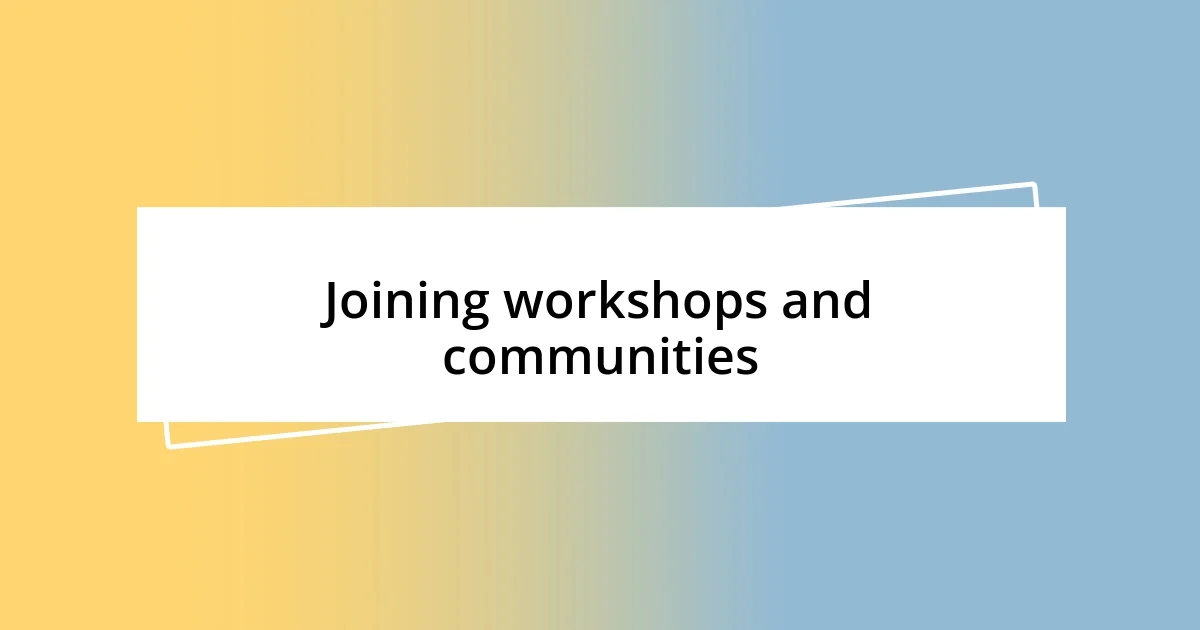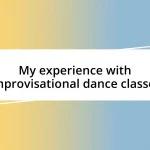Key takeaways:
- Trust and communication are essential in stage combat, as missteps can lead to injuries; every movement must be choreographed carefully for safety.
- Character development is enhanced through movement, allowing actors to express emotions and deepen audience connections by tapping into personal experiences.
- Joining workshops and communities fosters growth and mentorship, providing valuable insights and building lasting relationships with fellow stage combat enthusiasts.

Starting my stage combat journey
Stepping onto the stage for my first stage combat class felt like opening a door to a world I never knew existed. I remember the nervous flutter in my stomach as I watched experienced actors demonstrate swordplay with such precision; it was both intimidating and exhilarating. Have you ever felt that mix of fear and excitement when trying something new? I could hardly wait to jump in myself.
As I began learning the basics, I quickly realized that stage combat is as much about trust as it is about technique. I still recall the moment I paired up with a classmate for the first time. The intensity in their eyes matched mine, a shared understanding that we were about to tell a story through movement. It was in that moment—when the adrenaline surged and my heartbeat quickened—that I understood the power of conveying emotion through an art form that might seem purely physical.
With each practice, I found my confidence growing, but the journey was not without its challenges. I faced the frustration of missteps and at times, felt like I was stumbling in choreography meant to look seamless. But looking back, I realize that every mistake was a stepping stone. Have you ever noticed how our biggest struggles can lead to the most significant breakthroughs? That’s exactly how I felt as I started to embrace the complexity of stage combat, leading me to fully appreciate the art of storytelling in every strike and fall.

Essential techniques for beginners
Learning the essential techniques of stage combat can be a thrilling yet daunting journey. One key aspect I learned in those early classes was the importance of safety. I remember the moment my instructor stressed that every punch thrown must be choreographed with care. I felt an adrenaline rush but also a weight of responsibility as we practiced “pulling” our punches—making it look real without causing harm. This dramatic tension is what truly draws the audience in, and mastering that balance is fundamental for any beginner.
Here are some essential techniques to focus on as you embark on your stage combat journey:
- Body Mechanics: Understanding weight distribution and posture is critical. Your body should support your movements for both fluidity and safety.
- Distance Management: Always be aware of your spacing. This prevents accidents and ensures that performances look convincing without putting anyone at risk.
- Communication with your Partner: Establish signals and cues beforehand. This builds trust and ensures that both of you are on the same page during a performance.
- Controlled Speed: Start slow to grasp the moves correctly. As you grow more comfortable, you can gradually increase your speed, mimicking the intensity of real combat.
- Facial Expressions and Emotion: Combat isn’t just about physicality; it’s about storytelling. Channels your emotions through your face to elevate the scene, making it a captivating experience for the audience.
Reflecting on these techniques now brings back the exhilaration I felt when I finally landed a kick without hesitation—it felt like a breakthrough moment. Those early days taught me that stage combat is not just about the fights; it’s an intricate dance of connection and creativity.

Building character through movement
Building character through movement is a transformative experience that extends beyond the physicality of stage combat. I vividly remember a session where we explored the emotional weight behind each movement. As I practiced a scene that required vulnerability, I found myself tapping into past experiences that shaped my character’s journey. Have you ever thought about how your own stories influence how you express yourself? For me, it became evident that movement can be a powerful conduit for conveying depth, allowing the audience to truly connect with the characters we portray.
In another class, my instructor introduced us to the concept of ‘character-driven physicality.’ I was surprised how subtle changes in posture or gesture could transform my portrayal from a confident hero to a troubled soul. I decided to experiment with my body language—slouching my shoulders for a more defeated look and adjusting the way I held my arms. Instantly, I felt a shift in my presence on stage, and it also changed how I perceived my character. Movement is not just a means to an end; it’s a pathway to self-discovery and creative expression.
Lastly, during an intense rehearsal for a fight scene, I realized how movement can build relationships between characters. I was paired with a fellow actor, and we began to develop a non-verbal dialogue through our choreography. Each strike and parry wasn’t just about combat but served to deepen our characters’ motives and emotions. The trust we built through that physical connection reminded me of how pivotal relationships are in storytelling, both on stage and in life. It’s fascinating how movement can articulate what words sometimes fail to express.
| Movement Aspect | Impact on Character Development |
|---|---|
| Posture | Signifies confidence or vulnerability, shaping audience perception. |
| Gestures | Can convey emotions and intentions, building character depth. |
| Physical Timing | Creates dramatic tension and can mirror emotional stakes. |
| Proximity | Affects relationships, showing intimacy or conflict through spatial awareness. |

Practicing safety in stage fights
Practicing safety in stage fights is an absolute priority. I still remember the first time my partner and I rehearsed a complex sequence. We had to find a way to make it look intense while being mindful of each other’s space. In that moment, I realized how much trust was involved in stage combat; one wrong move could lead to an injury. Ensuring clear communication about our boundaries became a safety net we both relied on.
When practicing stage combat, using props safely is crucial. I had a scare once when we used a fake knife that looked shockingly real. Thankfully, we discussed how to handle it beforehand, confirming that we both knew what to expect. Have you ever thought about how something as simple as being proactive can keep everyone safe on stage? For me, it reinforced that preparation not only enhances the performance but also builds confidence in my fellow actors.
In my experience, warm-ups are essential before diving into choreographed fights. I recall a rehearsal where I took the time to stretch and focus on my breath. The difference was palpable during our staging; I was more agile and less prone to mishaps. It’s fascinating how taking those few extra minutes to mentally and physically prepare can drastically improve safety in what could otherwise become a chaotic scenario. Safety is not just a precaution—it’s a practice that adds depth to the performance itself.

Delivering believable performances
Delivering believable performances is all about authenticity and connection. I remember one rehearsal when I was asked to channel my fear during a fight scene. Instead of just acting scared, I asked myself what fear actually felt like in my body. It was surprising how much that reflection transformed my actions on stage, making them more visceral. Have you ever noticed how powerful those raw emotions can be?
During a performance, I found that the audience connects with the truth of what they see. I vividly recall a moment when I mishandled a prop, and instead of freezing, I let my character react. The genuine surprise in my response ended up drawing the audience in even more. It made me realize that the little imperfections could add layers of believability. Every actor has those moments; have you ever turned a slip-up into something magical on stage?
One of the most valuable lessons I’ve learned is that vulnerability resonates strongly with viewers. In a recent scene, I had to portray a character dealing with loss. I allowed myself to tap into my own experiences of grief, which brought a depth to my performance I hadn’t anticipated. I think it’s interesting how sharing a piece of our soul can break down barriers between the actor and the audience, making it an immersive experience for everyone involved. What do you find yourself tapping into when you need to deliver that authentic moment?

Joining workshops and communities
Finding workshops and communities dedicated to stage combat was a game-changer for me. I remember my first workshop vividly; stepping into a room filled with passionate individuals, all eager to learn and collaborate, was exhilarating. It was refreshing to share this unique interest with others who understood the intricacies and dedication that come with mastering physical storytelling. Have you ever experienced that electrifying energy when you’re surrounded by like-minded people?
Joining these workshops also opened doors to invaluable mentorship. During one session, I was paired with a seasoned veteran who not only demonstrated techniques but also shared stories from their own journey in theatre. Their guidance made me realize the importance of learning from those who had walked the path before me. It’s amazing how one conversation can broaden your perspective—have you ever had a mentor who shifted your approach to a craft?
The communities I encountered were just as impactful as the technical skills I acquired. Engaging with fellow enthusiasts on social media platforms or local meet-ups helped me build connections that extended beyond the workshops. I recall a gathering where we discussed our favorite fight scenes in film and the adrenaline of performing live. Those discussions not only fueled my inspiration but also sparked friendships that have lasted well beyond the training sessions. Aren’t those shared moments important in creating a supportive environment?














